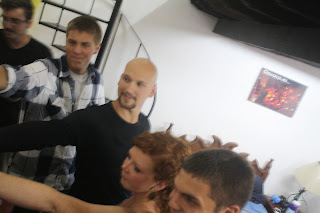After coming home from Oaxaca, I needed to write a report about my time abroad to complete a small scholarship I had received. The following is the reflection I wrote:
Before I left Minneapolis to fly to Oaxaca, I
didn’t know what to expect. All I really
knew for sure was that Oaxaca was going to be different from anywhere I had
ever lived before. I was excited about
that, but uncertain what “different” would look like.
I did my best to keep an open mind and minimize
what my expectations were. There were so
many unknowns, and I tried to remain at peace about that. Examples of questions going through my mind
were:
What
will the hotel be like where I am staying?
Where in the city will
we be living? How far away is it from school?
How will I exchange
money? Will there be a bank near my hotel?
Will I be able to
cook? Will there be a place to store
food?
How expensive or
inexpensive will food be?
How do they celebrate holidays? Is it festive in the city?
Is there public
transportation that I will be able to use? How isolated is the city?
Will my Spanish
improve? Will people know English?
How traditional will
the city be? What does “traditional
Mexican culture” look like?
Will people receive us warmly? How do Mexicans feel about Americans?
The studio culture our group formed was a very
special part of the experience. There
were seventeen of us, and we became family.
We worked collaboratively, using each other as resources at all hours of
the day/night. And in the moments when I
needed support, I was overwhelmed by the love my friends showed me. Our professor, Lance Lavine, did the
same. Professor Lavine not only invested
in our development as students but also took the time to get to know us as
people.
Academically and professionally, the Oaxaca program
played an integral role in my development.
Professor Lavine was intentional about bringing in architects and other
professionals both from Latin American countries as well as University of
Minnesota. They came to our studio to
give feedback and often gave a lecture to show their work. It was incredibly valuable to have our work
critiqued in the development and final stages of the project by professionals
who had articulate insight. I have never
before had the opportunity to have my work reviewed so often and intimately by
professionals in the field. Also, these
close interactions with professionals allowed me to begin to imagine myself in
their position. Oaxaca solidified my
desire to continue pursuing a career in Architecture.
Oaxaca is a place that will forever remain close to my heart. The city is rich with color and warmth—both
in a literal sense and inter-personally.
In the historical center of the city, where we lived, the building style
is uniformly traditional: stucco façade over stone and brick construction,
rarely more than two stories tall. To
me, the best part of these stucco buildings was the vibrant colors that
building owners chose to paint their exterior.
No building was ever simply white and no two buildings were painted
exactly the same. Each building was
nestled into its neighbor and came right up to the sidewalk. We had to laugh because some of the sidewalks
were so narrow that it felt as if the building was spilling over onto the
street.
The people of Oaxaca took every opportunity to
celebrate. If there was no reason to have
a parade one week, it seemed that they made up a reason to do so. In America I’m used to traffic jams because
of getting stuck behind a train, a car accident, etc. In Oaxaca, it’s parades. I saw one parade for “National Water Day,”
another for a political cause, and a huge processional for Good Friday, to name
just a few. When there is a wedding, the
family hires a band and people to spin around with double-life-size puppets for
the groom and bride. The family all
gathers outside the church and in the street passing around bottles of
mescal. I loved the Mexican normalcy of
celebrating.
“Taking a siesta” was a new concept for me. In the heat of the day, typically between 2
and 4, the whole city shuts down. Shop
owners go for lunch, workers roam the parks, and adolescent teenagers take that
time to publically display their affections.
It was a really beautiful thing to be a part of a culture that takes a moment
to breath and moves a little slower all together.
Another thing I was positively struck by was
Mexican modesty even in the face of a 110-degree heat wave. Air-conditioning is practically non-existent
in Oaxaca. All the same, women would
wear skirts and tops of modest length, and the men would wear pants year
round. When I have experienced the same
heat conditions in the States, our society seems to use it as an excuse to walk
around in the shortest shorts and barely there tops, quickly retreating to
air-conditioned homes. It was a humbling
lesson to learn that one can remain modestly clothed in the heat and survive
just fine.
In the most practical sense, I was thankful to have
the opportunity to travel to Oaxaca for two key reasons: I didn’t have to take
out a loan to do so, and I am still on track to graduate in four years. The program is unbelievably inexpensive,
especially in comparison to other programs in Europe. Mexico itself is affordable, as well, which
made it possible for our group to have some fun without breaking our budgets.
If I could do it again, the only thing I would
change would be to pack even lighter and buy less. Living minimally was refreshing and a great
life lesson for me.

















